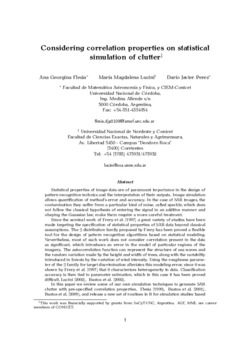| dc.contributor.author | Flesia, Ana Georgina | |
| dc.contributor.author | Lucini, María Magdalena | |
| dc.contributor.author | Pérez, Darío Javier | |
| dc.date.accessioned | 2021-12-14T18:45:34Z | |
| dc.date.available | 2021-12-14T18:45:34Z | |
| dc.date.issued | 2015 | |
| dc.identifier.uri | http://hdl.handle.net/11086/21981 | |
| dc.description.abstract | Statistical properties of image data are of paramount importance in the design of pattern recognition technics and the interpretation of their outputs. Image simulation allows quantification of method?s error and accuracy. In the case of SAR images, the contamination they suffer from a particular kind of noise, called speckle, which does not follow the classical hypothesis of entering the signal in an additive manner and obeying the Gaussian law, make them require a more careful treatment. Since the seminal work of Frery et al. (1997) a great variety of studies have been made targeting the specification of statistical properties of SAR data beyond classical assumptions. The G distribution family proposed by Frery has been proved a flexible tool for the design of pattern recognition algorithms based on statistical modeling. Nevertheless, most of such work does not consider correlation present in the data as significant, which introduces an error in the model of particular regions of the imagery. The autocorrelation function can represent the structure of sea waves and the random variation made by the height and width of trees, along with the variability introduced in forests by the variation of wind intensity. Using the roughness parameter of the G family for target discrimination alleviates this modeling error, since it was shown by Frery et al. (1997) that it characterizes heterogeneity in data. Classification accuracy is then tied to parameter estimation, which in this case it has been proved difficult, Lucini (2002), Bustos et al. (2002). In this paper we review some of our own simulation techniques to generate SAR clutter with pre-specified correlation properties, Flesia (1999), Bustos et al. (2001), Bustos et al. (2009), and release a new set of routines in R for simulation studies based on such techniques. We give an example of the code versatility studying the change in accuracy of non-parametric techniques when correlated data is classified, compared with classification of uncorrelated data simulated with the same parameters. All code is available for download from AGF?s Reproducible Research website, Flesia (2014). | es |
| dc.description.sponsorship | This work was financially supported by grants from SeCyT-UNC, Argentina. AGF, MML are careermembers of CONICET. | en |
| dc.format.medium | Impreso | |
| dc.language.iso | eng | es |
| dc.rights | Attribution-NonCommercial-NoDerivatives 4.0 International | * |
| dc.rights.uri | http://creativecommons.org/licenses/by-nc-nd/4.0/ | * |
| dc.source | ISBN: 9781848901711 | |
| dc.subject | Stochastic simulation | es |
| dc.subject | Radar images | es |
| dc.subject | G0 distribution | es |
| dc.subject | Segmentation classification | es |
| dc.title | Considering correlation properties on statistical simulation of clutter | es |
| dc.type | bookPart | es |
| dc.description.version | info:eu-repo/semantics/submittedVersion | |
| dc.description.fil | Fil: Flesia, Ana Georgina. Universidad Nacional de Córdoba. Facultad de Matemática, Astronomía y Física; Argentina. | es |
| dc.description.fil | Fil: Flesia, Ana Georgina. Consejo Nacional de Investigaciones Científicas y Técnicas. Centro de Investigaciones y Estudios de Matemática; Argentina. | es |
| dc.description.fil | Fil: Pérez, Darío Javier. Universidad Nacional de Córdoba. Facultad de Matemática, Astronomía y Física; Argentina. | es |
| dc.description.fil | Fil: Pérez, Darío Javier. Consejo Nacional de Investigaciones Científicas y Técnicas. Centro de Investigaciones y Estudios de Matemática; Argentina. | es |
| dc.description.fil | Fil: Lucini, María Magdalena. Universidad Nacional de Nordeste. Facultad de Ciencias Exactas, Naturales y Agrimensura; Argentina. | es |
| dc.description.fil | Fil: Lucini, María Magdalena. Consejo Nacional de Investigaciones Científicas y Técnicas; Argentina. | es |
| dc.journal.referato | Con referato | |
| dc.description.field | Ciencias de la Información y Bioinformática (desarrollo de hardware va en 2.2 "Ingeniería Eléctrica, Electrónica y de Información" y los aspectos sociales van en 5.8 "Comunicación y Medios") | |
| dc.book.country | Reino Unido | |
| dc.book.editorial | College Publications | |
| dc.book.pages | 220 | |
| dc.book.volume | 0025 | |
| dc.book.title | Learning and inferring. Festscrift for Alejandro C. Frery on the Occasion of his 55th Birthday | en |





